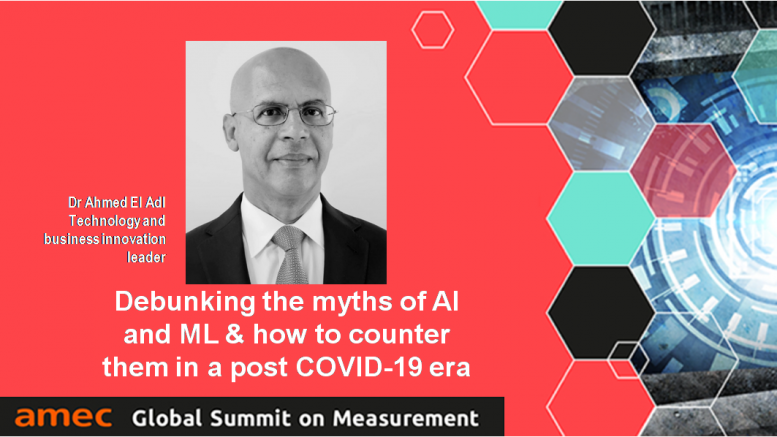While the acceptance of AI in mainstream society is a comparatively new phenomenon, how is it impacting the business world? Over the last decades, it was mainly on the academic side, that AI overcame many obstacles. Significantly, the AI technologies and required tools are maturing very quickly.
And recently, over the last years AI started to face one of its major challenges – that is the adoption in real-world business scenarios. With all the noise around AI, business leaders started to discover the value of AI technology for their business purpose and business customers. It has been challenging for business leaders to distinguish between facts and fiction in the rapidly crowded and noisy ecosystem.
AI – the right tool?
Looking back, at what was once the realm of science fiction, we remember films like ‘ET’, but the reality today is that AI in business intelligence is evolving into an everyday business.
In his talk Dr. Ahmed El Adl, Technology and business innovation leader, said, “Today I will not talk about the fancy side of AI, but the ugly side of AI adoption and what are the myths that led to major failure and how to avoid it”. So his talk was focused on highlighting some of the key myths and how to counter them, so that both businesses and society can leverage AI – to achieve progress safely and effectively.
Post-COVID, misinformation is costing lives too and business glitches.
The AI cold winter is over?
AI is not a new thing. The beginnings of modern AI can be traced to 1956, at a conference at Dartmouth College, in Hanover, New Hampshire, where the term “artificial intelligence” was coined. MIT cognitive scientist Marvin Minsky and others who attended the conference were extremely positive about AI’s future. As early as the late 90s we entered the AI era.
High performance computing is available to encourage business; plus there is enough data, real time accuracy and accessibility of data to transfer to cloud. The networks and unlimited computing resources led to enterprise-ready AI platforms, which made it easy to implement AI-based solutions in business.
Understanding AI
What is AI? There are four capabilities of the AI system, he explained. It displays ‘sense’ (should sense be aware of the right data?), comprehend (analyze, reason and understand data), communicate, act & react) and learn (continuously to be smarter, more capable over time). But, he has a word of caution – an AI system that is not always learning, it can be unreliable and can be dangerous!
Presenting the multi-faced situation of AI adoption was varied. There was a lot misinformation and misunderstanding as far as businesses were concerned. There was strong curiosity and enthusiasm from many people and companies, which resulted in large investments. Unfortunately there were confusing, conflicting messages about what AI can and cannot do. There were serious efforts by vendors and academic to adjust approaches of adoption and expectations.
Myths vs Facts
AI technology not ready for industrial adoption: Like human, AI algorithms need more real-world experience. Computer Vision (CV) and Natural language Processing (NLP) are the most mature and widely adopted parts of AI today. There are high quality AI platforms and automation tools. Dr. Ahmed said, “We have data, but not in the right quality. Therefore, we need to identify the data – the right quality, quantity and we are far from that!” The message here is – we need to understand what we need and how to use it.
AI is all about ‘Big Data’: The human brain was initially trained with less data but it was extended and continuously optimized with large amounts of data. There is increased warning among scientists against the statistical inference – P values, ie Probability Value. AI is not only about Big Data, but the quality and quantity of data and how we are going to use data to get the machine to do better over time, he disclosed.
AI solutions are more secure and safe to use: Intelligent solutions should be able to defend themselves? Current AI solutions can be easily misled to take wrong or even dangerous decisions. The ability of continuous learning could be a “double-edged sword”. Hacking AI systems to drive wrong decision is the new weakness of the AI system. “You need to test for misinformation,” was his advice.
AI bias: The AI bias is not a societal bias. Is it artificial stupidity or artificial intelligence? For companies regulations are required until governmental regulations exist and are effective. A lot of bias tests have to be done, and you have to be aware of categorical biases, he pointed out. “My recommendation is – be aware of AI bias. We have to create international rules,” was what he opined keeping the future in mind.
The cognitive ‘Digital Twin’
An emerging topic is the cognitive ‘Digital Twin’. A cognitive digital twin is a tool that can boost current profiling and act as an intermediator of knowledge, in both direction. But there are hidden dangers of cognitive digital twin. Digital Twins execute conscious actions. The lesson to remember here is to define the business problems, and then decide which problems are best solved with Artificial Intelligence.
Dr. Ahmed pondered over how it can be used in communication. When you evaluate media content, you don’t take snapshots. Even if you do, you have to put it in the right context. The Digital Twin was created by NASA to simulate in a context and as a protective action. But today we have data, knowledge, technology, but as a communication specialist – how can I correctly measure?
How can it be used in communication? If I use ‘Digital Twin’ to create a base of knowledge, which can be used by a system to put in the right context to get the right insight? You have to communicate the right content and also evaluate feedback, as his feedback.
However, after we emerge from the pandemic, and the world gets into some order, the truth and reality of AI will endure. And how!
The views and opinions published here belong to the author and do not necessarily reflect the views and opinions of the publisher.






Be the first to comment on "Debunking the myths of AI and ML & how to counter them in a post COVID-19 era"